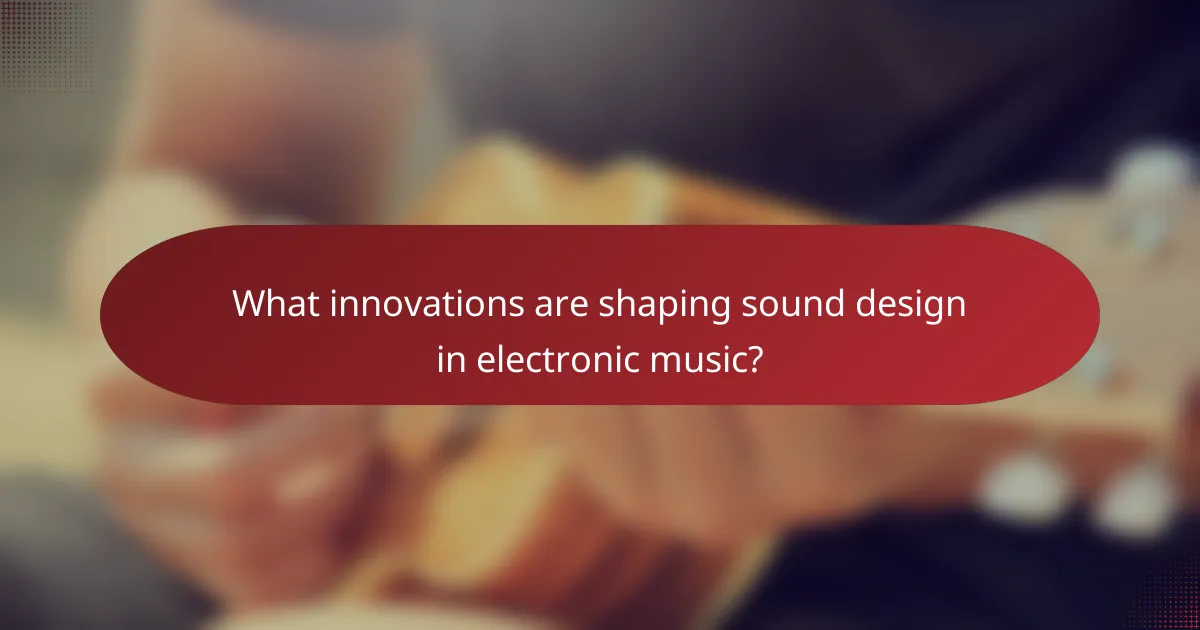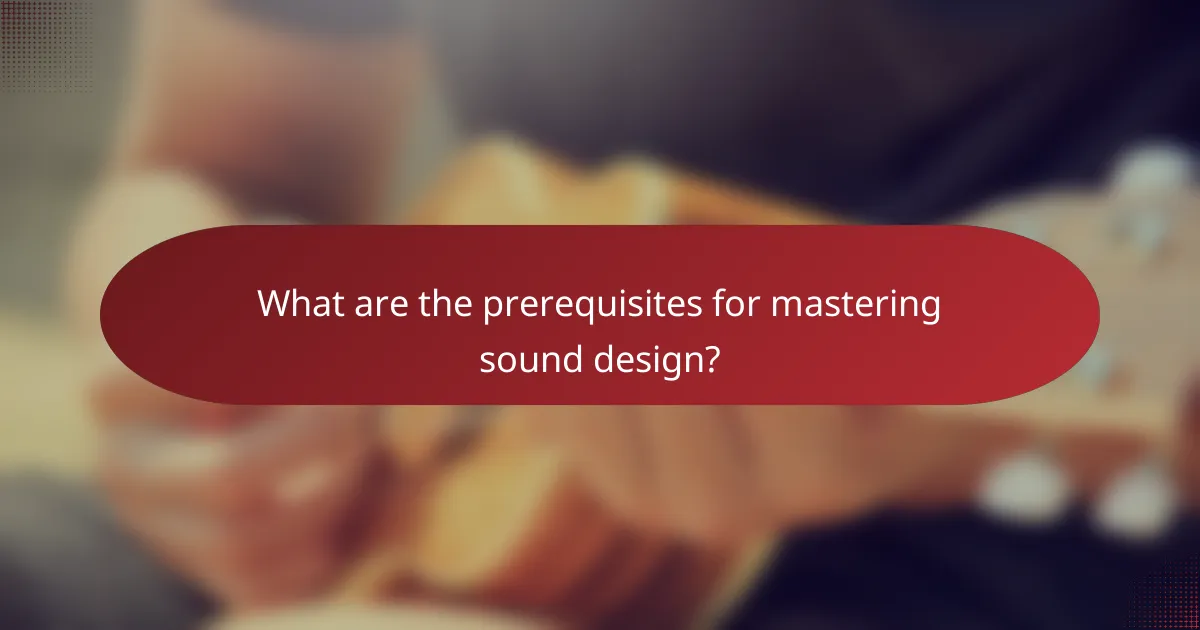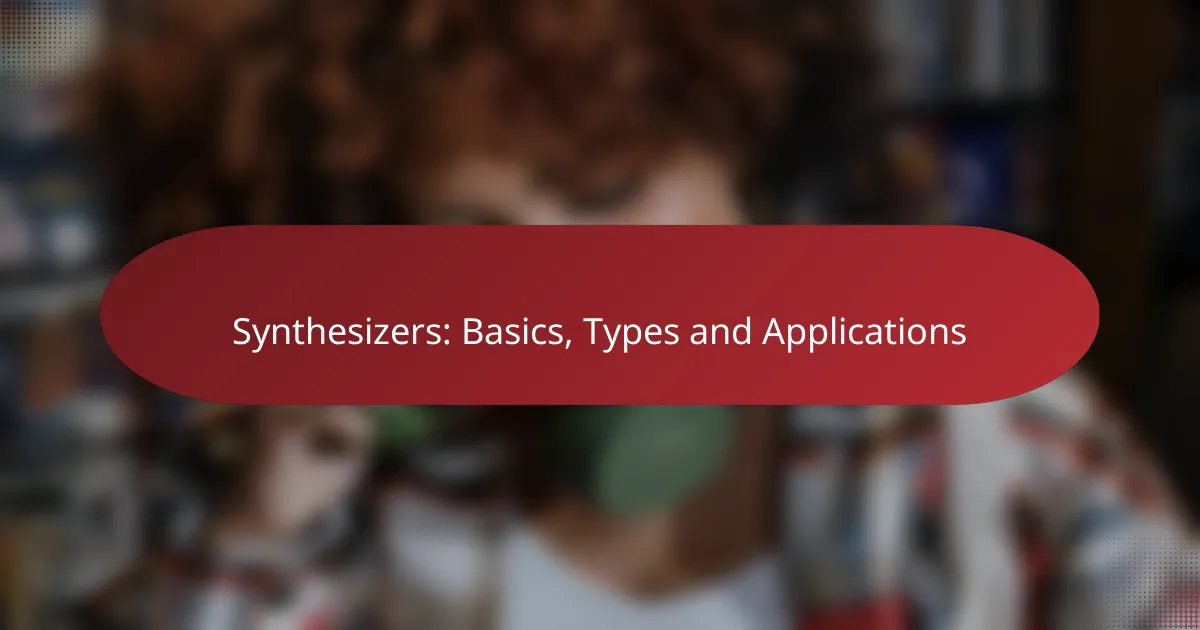Sound design for electronic music is a vital aspect that shapes the genre’s identity, utilizing techniques such as layering, synthesis, and effects processing to craft distinctive sounds. By exploring various styles, from ambient soundscapes to techno bass design, artists can create rich auditory experiences that resonate with listeners. Selecting the right software tools, including DAWs and plugins, is essential for achieving the desired creative outcomes in this dynamic field.

What are effective sound design techniques for electronic music?
Effective sound design techniques for electronic music involve a combination of layering, synthesis, effects processing, sampling, and field recordings. These methods help create unique sounds and textures that define the genre.
Layering sounds
Layering sounds is a fundamental technique in electronic music that involves combining multiple audio tracks to create a richer and more complex sound. This can include stacking different synths, samples, or effects to enhance depth and texture. For instance, layering a bass synth with a sub-bass can produce a fuller low-end presence.
When layering, consider the frequency spectrum to avoid muddiness. Use EQ to carve out space for each layer, ensuring clarity and balance. A common approach is to layer sounds that complement each other, such as a bright lead with a warm pad.
Using synthesis methods
Synthesis methods are crucial for generating sounds from scratch in electronic music. Techniques like subtractive, additive, and FM synthesis allow for diverse sound creation. Subtractive synthesis, for example, involves filtering harmonics from a rich waveform to shape the desired tone.
Experimenting with different waveforms and modulation techniques can yield unique results. For instance, using an LFO to modulate the filter cutoff can create movement and interest in a sound. Familiarize yourself with various synthesizers to understand their capabilities and limitations.
Applying effects processing
Effects processing enhances sounds and adds character in electronic music production. Common effects include reverb, delay, distortion, and modulation effects like chorus or flanger. Each effect can dramatically alter the perception of a sound, making it more engaging.
When applying effects, consider the context of the mix. For example, a subtle reverb can create a sense of space, while heavy distortion can add aggression. Use effects judiciously to avoid overwhelming the original sound, and always check how they interact with other elements in the mix.
Sampling techniques
Sampling techniques involve using pre-recorded sounds to create new compositions. This can range from using snippets of existing tracks to creating entirely new sounds from found audio. Sampling allows for creativity and can introduce unique textures into your music.
When sampling, ensure you have the right to use the audio, especially if it’s from copyrighted material. Tools like samplers and DAWs can help manipulate samples, allowing for pitch shifting, time stretching, and layering to fit your project.
Field recordings
Field recordings capture real-world sounds and can add an organic element to electronic music. These recordings can include anything from nature sounds to urban noise, providing a unique sound palette. Incorporating field recordings can create a sense of place and atmosphere in your tracks.
To effectively use field recordings, consider how they blend with your electronic elements. You might process them with effects to match the style of your music or use them as rhythmic elements. Always pay attention to the quality of the recordings to ensure they enhance rather than detract from your overall sound.

How to choose the right software for sound design?
Choosing the right software for sound design involves considering your specific needs, budget, and workflow preferences. Look for digital audio workstations (DAWs) and plugins that align with your creative style and technical requirements.
Popular DAWs for electronic music
Some of the most popular DAWs for electronic music include Ableton Live, FL Studio, and Logic Pro. Each offers unique features tailored for sound design, such as intuitive interfaces, robust MIDI capabilities, and extensive libraries of sounds.
Ableton Live is favored for its session view, which allows for flexible arrangement and live performance. FL Studio is known for its user-friendly pattern-based workflow, while Logic Pro provides a comprehensive suite of tools for both sound design and music production.
VST plugins for sound design
VST plugins are essential for enhancing sound design capabilities within your DAW. Popular options include Serum, Massive, and Omnisphere, each offering a range of synthesis methods and sound manipulation tools.
Serum is renowned for its wavetable synthesis, allowing for intricate sound shaping. Massive excels in creating powerful bass and leads, while Omnisphere is celebrated for its vast library of high-quality sounds and textures, making it versatile for various genres.
Comparison of software features
When comparing software features, consider aspects such as ease of use, sound quality, and available sound libraries. Look for DAWs and plugins that offer a good balance of these elements based on your skill level and production goals.
For instance, if you prioritize live performance, Ableton Live’s session view may be more beneficial than a traditional linear DAW. Additionally, check for compatibility with your operating system and hardware, as well as the availability of support and community resources.

What styles of sound design are prevalent in electronic music?
Electronic music features a variety of sound design styles that define its unique character. Key styles include ambient soundscapes, techno bass design, and house music synths, each with distinct techniques and applications.
Ambient soundscapes
Ambient soundscapes create immersive audio environments, often characterized by long, evolving tones and textures. These sound designs typically utilize synthesizers, field recordings, and effects like reverb and delay to build atmospheric layers.
To craft effective ambient soundscapes, focus on sound selection and modulation. Use pads and drones that evolve over time, and consider incorporating natural sounds to enhance realism. A common approach is to maintain a slow tempo, allowing listeners to explore the sonic space without distraction.
Techno bass design
Techno bass design emphasizes powerful, driving basslines that form the foundation of many tracks. This style often employs synthesizers like the Roland TB-303 or modern virtual instruments to create deep, resonant bass sounds.
When designing techno bass, consider using techniques such as sidechain compression to achieve a pumping effect, which enhances the rhythm. Experiment with distortion and filtering to add character and presence. Aim for a bass frequency range typically between 40 Hz and 100 Hz for optimal impact on club sound systems.
House music synths
House music synths are essential for crafting the upbeat and melodic elements that define the genre. Commonly used synthesizers include the Roland Juno series and various software plugins that emulate classic sounds.
For house music, focus on creating catchy hooks and chord progressions using saw waves and square waves. Layering different synth sounds can add richness and depth. Keep in mind the importance of groove; syncopated rhythms and swing can elevate your synth lines and engage listeners on the dance floor.

What innovations are shaping sound design in electronic music?
Innovations in sound design for electronic music are primarily driven by advancements in technology, particularly in artificial intelligence, spatial audio, and real-time manipulation techniques. These innovations allow artists to create more immersive and dynamic soundscapes, enhancing the listener’s experience.
AI-driven sound generation
AI-driven sound generation utilizes algorithms to create unique sounds and musical compositions. These systems analyze existing music and can produce new audio that mimics various styles or genres, offering artists a powerful tool for inspiration and experimentation.
When using AI for sound design, consider the balance between human creativity and machine-generated content. While AI can generate a vast array of sounds, it’s essential to refine and personalize these outputs to maintain artistic integrity. Tools like OpenAI’s MuseNet or Google’s Magenta are popular for exploring AI-generated music.
Spatial audio techniques
Spatial audio techniques enhance the listening experience by creating a three-dimensional sound environment. This approach allows sounds to be perceived as coming from different directions, making the audio more immersive. Technologies such as Dolby Atmos and Ambisonics are commonly used in electronic music to achieve this effect.
To effectively implement spatial audio, consider the playback system and the audience’s listening environment. Use binaural mixing for headphone listening, while surround sound setups can enhance live performances. Experimenting with panning and distance effects can also enrich the spatial experience.
Real-time sound manipulation
Real-time sound manipulation involves altering audio signals on-the-fly during performances or recordings. This technique allows artists to create dynamic soundscapes that respond to the energy of the moment, making each performance unique. Tools like Max/MSP and Ableton Live are popular for real-time manipulation.
When incorporating real-time sound manipulation, focus on the responsiveness of your setup. Ensure that your hardware and software can handle the processing demands without latency. Practice with different effects and controls to develop a fluid performance style that captivates your audience.

What are the prerequisites for mastering sound design?
To master sound design, one must have a solid understanding of audio fundamentals and a familiarity with music theory. These prerequisites provide the essential knowledge and skills needed to create and manipulate sounds effectively in electronic music.
Understanding audio fundamentals
Audio fundamentals encompass the basic principles of sound, including frequency, amplitude, and waveforms. Knowing how these elements interact allows sound designers to shape audio effectively, whether through equalization, compression, or effects processing.
Key concepts include understanding the frequency spectrum, which ranges from low bass (20 Hz) to high treble (20 kHz). Familiarity with terms like decibels (dB) for volume and hertz (Hz) for pitch is crucial. For example, a low-pass filter can be used to remove high frequencies, creating a warmer sound.
Familiarity with music theory
Music theory provides the framework for creating melodies, harmonies, and rhythms. A basic grasp of scales, chords, and song structure can significantly enhance a sound designer’s ability to craft compelling musical pieces. Understanding how different notes interact can lead to more harmonious soundscapes.
For instance, knowing how to build a chord progression can help in layering sounds effectively. A common pitfall is neglecting the relationship between sounds; always consider how each element fits into the overall composition to maintain coherence and musicality.










